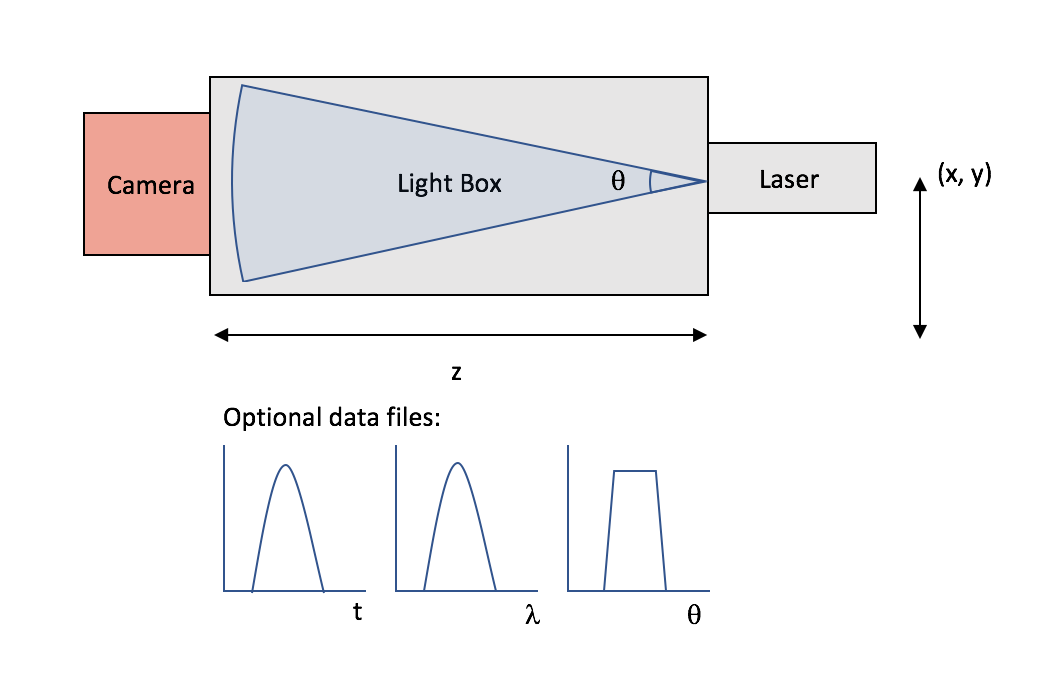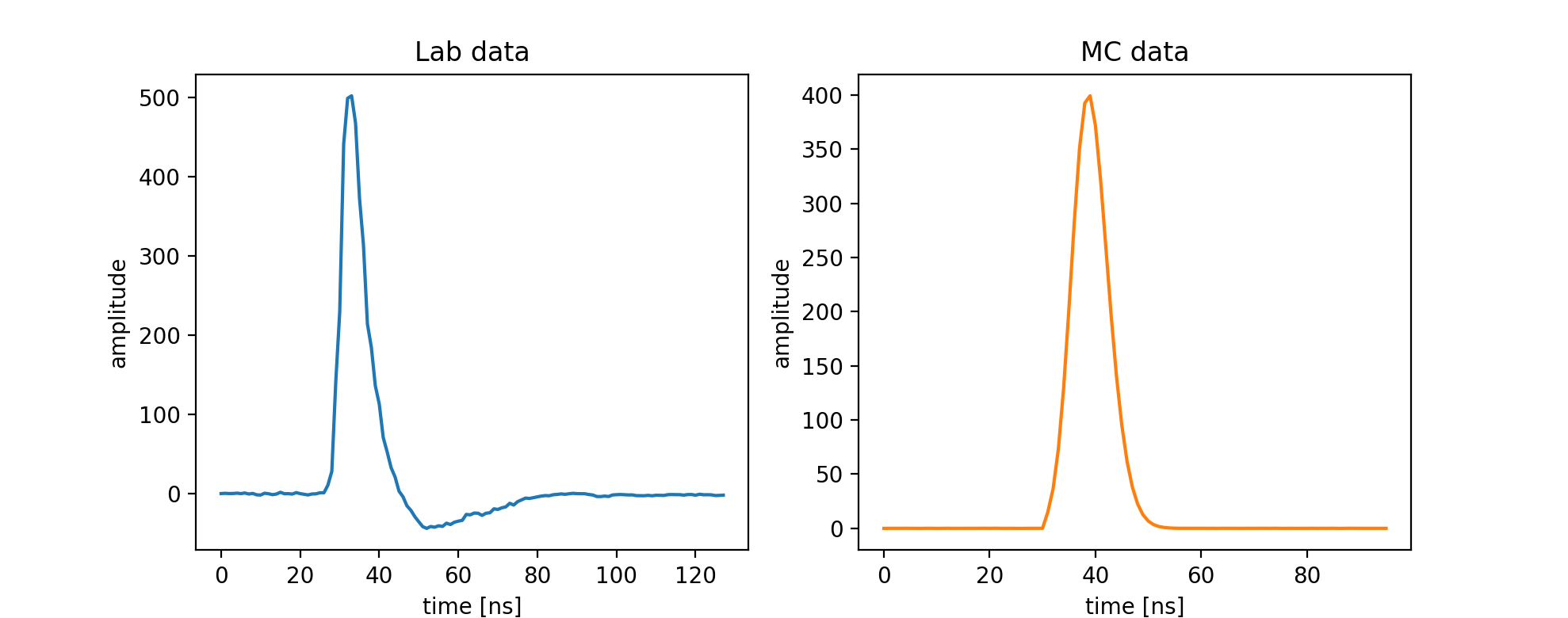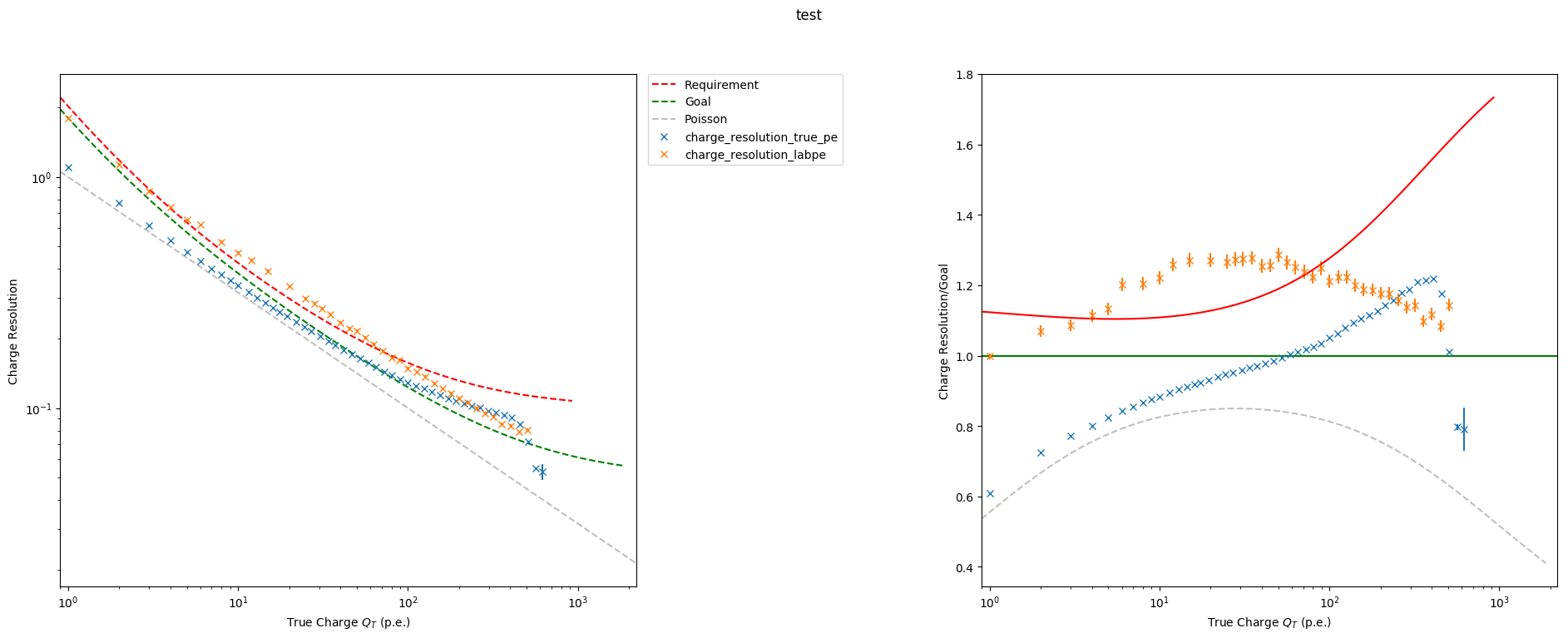The goal of this repository is to create some scripts and examples of how to produce and analise the MC data for the MCValidation process, focusing on using the LightEmission package to replicate lab measurements. See mcmeas.pdf which lays out some of the test measurements that will be used, and are generally grouped in the following cases: Pedestal and noise measurements, basic photo-sensor response, pulsed light measurements with external trigger, pulsed light measurements with camera trigger and electronic test pulses instead of light pulses. Before looking at each one of these it is important to evaluate the tools that we need for this process.
In order to simulate the lasers used in lab measurements and which can be read in by sim_telarray, we utalise the LightEmission package created by K Bernloehr (now part of the latest corsika_simtel distribution) which enables a generic light source to be defined by the number of emitted photons, light temporal, spectral and angular distribution (or single values).
One initial difficulty is defining the desired number of photo-electrons emitted as part of the light source. In lab measurements the different light levels are generally created using a filterwheel, and the absolute illumination is calibrated by measuring the detected number of photo-electrons and calibrate it using the single p.e. measurements [Needs confirmation and better description]. For now a simple approach has been adapted that takes the input requested geometry and the photon detection efficiency (along with any other transmission factors) to calculate the required number of photons needed to produce a desired (average) number of photo-electrons.
See the script get_photons.py which reads in a run list and provides the required number of photons emitted in LightEmission package to obtain the desired p.e. level.
python get_photons.py --runfile <File> --outfile <File> --pdefile <File> --transmission <File> --wavelength 400 --camera CHEC --ls_distance 1.5 --angular_distribution <File>
Looking at the distribution of true mc p.e. recorded from the simulation compared to the requested input (see following image), we see that they agree reasonably well. There is, as is expected a slight bias due to the geometry and, in this case the curved focal plane, where we expect to see fewer photo-electrons towards the edge of the camera.
Note that script doesnt doesn't currently take into account full distributions of wavelength or angle (issue #1). The light source can then simply be simulated by running the following
./ff-1m --events <Nevents> --photons <Nphotons> --distance <z> --camera-radius <Rcam> --angular-distribution <File/isotropic> --spectrum <File/value> <(x, y)> -o <File>
which will produce a data file which is in the same format as a corsika file. This is put into sim_telarray using what ever configuration that represents the camera you are simulating. Note that the additional flag BYPASS_OPTICS needs to be set in order to prevent the telescope structure and mirrors. A helper script has been created, run_simtel.py which runs the light emission package and sim_telarray. Also can generate a pixel mask file
example run:
python run_simtel.py --infile runlist.txt --outdir ~/Data/test_run --nevents 1 --runLightEmission --angdist ./angular_distribution.dat
--distance 100 --camradius 30 --runSimTelarray --nsb 0 --discthresh 0
Note you need to add
export CORSIKASIMTEL="path to your corsika simtel verison"
export MCVAL="path to your MCValidation folder"
in your bashrc
Note: for a lot of test measurements, it should be possible to set the transmission and pde to 100% which should just result in fewer photons being simulated (i.e. save some cpu and storage space)
Additionally, there are some helper scripts for the helper script... (the example...py). But these are mainly here to keep track of some different runs performed and will be replaced with config files shortly (see issue #2).
For this work, we assume that the data is organised as separate runs (RunX.format) in a folder which has a corresponding runlist.dat, where the dat file contains columns describing the data run (RunNumber, Filterwheel_position, Filterwheel_attenuation, Npe, Nphotons*, Nevents, NSB+noise, discriminator_threshold) e.g.
#run_number fw_pos fw_atten pe_expected ph_required n_events NSB disc_thresh
43469 2782 2.51189 1008.67 23685422.72 100 0.005 20
43470 2756 2.81838 898.98 21109700.22 100 0.005 20
43471 2728 3.16228 801.21 18813881.19 100 0.005 20
... ... ... ... ... ... ... ...
Where fw_pos, fw_atten are not used at the moment
In order to read in data from the different cameras, readers in ctapipe need to be implemented and if necessary the relevant camera softwehere needs to be installed.
There are plenty of example scripts available in ctapipe/examples. Here we simply put a few specific examples that have been created here.
compare_waveforms.py - simple script to view waveforms in parallel for lab and MC, this can simply be run as
python compare_waveforms.py --mcfile data/runX.simtel.gz --labfile data/runX.format
which would give you all the waveformes in each file, but there are also some extra flags that let you select pixels etc. The output should look something like:
This script can also be passed just one file if desired.
The following are measurement categories taken from mcmeas.pdf meantioed at the start. The quotes are the text extracted from the document followed by description of the method(s) that will be implemented.
Baseline (pedestal) measurements without any light source and with increasing levels of nonpulsed background light (emulating NSB over the expected range in observations, e.g. from zero to maximum operational rate in the requirements). The documentation must include how the rates were determined. Where possible, such measurements should be available with both the readout window length as intended for later operation and with a window length as long as possible to extract also lower-frequency noise contributions. (Single sensors or camera parts. Relevant for MC parameters and algorithms related to pedestals, electronics noise, and dark count rates.)
To simulate this, there are now two methods. 1) Simply use a dummy corsika event (such as one created by the flatfielding code with only 1 photon) and increase the NSB parameter, or 2) use the new NSB code, nsbls, available with the LightEmission package.
See code extract_pedistal.py
For normal incidence the PDE (photon detection efficiency) for SiPM at the bias voltage as used in the camera. QE and CE (quantum efficiency / collection efficiency) for PMTs, over the light collector exit area, using a mask in front of the photocathode, at nominal gain. (Single sensors or camera parts. Not all of these measurements will have a direct comparison in simulations, e.g. when measuring the photocathode currents for the quantum efficiency of PMTs.)
Not considered for now.
Light collector plus photosensor efficiency versus angle of incidence, either in absolute units as for normal incidence or relative to the efficiency of the masked PMT (and scaled of light collector exit area over entry area).
This could be performed by setting the position of the light source and angular distribution in order to match a specified measurement, however this could only be done relative to on axis efficiency. Not considered for now.
Afterpulsing measurements for PMTs (between 4 and 40 p.e. or to amplitudes beyond which the afterpulse probability is < 10−9), revealing integral afterpulse fractions and spectrum of afterpulses. Either with non-pulsed light source or cumulative over all relevant afterpulsing delays. In order to have a reproducible p.e.-scale, raw data taken with camera electronics is recommended for this purpose, together with matching calibration measurement data. Other ways to measure afterpulsing are acceptable as long as the p.e. scale is well-defined.
It seems like this is only nescesery to provide the data for the pm_photoelectron_spectrum parameter?
SiPM dark count measurements at the bias voltage as used in the camera, revealing dark count rate and pure optical-cross talk probability. In addition to measurements with the camera electronics, additional measurements with low-noise electronics are appreciated for this purpose, in particular for the width of the individual peaks in the amplitude distribution.
Same as above? Do we want to be able to reproduce the measured SPE? For this then we just need to have a script to create the SPE distribution. Code for this already exists but I can include it here. Issue #4
Pulsed light measurements at low illumination levels (“single-p.e.”) together with off-pulse (“dark”) control measurements. For disentangling the single-p.e. response from the superposition of multiple photoelectrons, measurements at multiple illumination levels – best with known attenuation ratios – from well below one p.e. up to a few p.e. are recommended but knowledge of absolute levels is not necessary. At operational gain (PMT) or bias voltage (SiPM). Measurements with the readout system of the camera are suitable for gain calibration (matching pedestal measurements also needed). Measurements with separate low-noise readout suitable for r.m.s. width of the individual peaks in the SiPM amplitude distribution and, for PMTs, for following the single-p.e. amplitude distribution down to lower amplitudes than available with the camera readout.
Setting up measurements for gain calibration shouldnt be to hard, just need script to derive the single p.e. spectrum.
Pulsed light measurements at moderate illumination levels (flat-fielding style) with external trigger, for pulse shapes and timing accuracy. Proper documentation of light pulse intrinsic shape is necessary. Also documentation on the stability of the external trigger with respect to the actual light pulse. Changing illumination levels via known optical attenuation, also down to low levels for corresponding single-p.e. calibration, is preferred but other types of attenuation are acceptable as long as attenuation ratios, light pulse shape, and trigger delay are under control. These measurements are most likely available as part of the charge resolution validation, B-xST-1010 and the time resolution validation, B-xST-1030. They may include different levels of emulated NSB. (Requires a significant part of a camera.)
This involves simulating a dynamic range run, script to obtain the charge resolution already exists, see extract_trigger_efficiency.py. The required documentation of the pulse intrinsic shape will be used to setup the light source simulation.
exctract_charge_resolution.py
python extract_charge_resolution.py --input_path ./d2018-02-09_DynRange_NSB0_mc --max_events 10 -o ./charge_resolution_test.h5 --calibrator HESSIOR1Calibrator -T 1 --plot_cam False --use_true_pe True
result can be plotted using
python .../ctapipe/ctapipe/tools/plot_charge_resolution.py -f="['./charge_resolution_true_pe.h5', './charge_resolution_labpe.h5']" -O ./comp_charge_res.png
Pulse shapes at different pulse illumination levels (available with previous set of measurements for all camera types with trace readout). In addition to readout of normal trace length it may also be useful to obtain measurements with longer readout covering the tails of the pulses.
Simple to implement, obtain average pulse shape/waveform at each illumination.
Instead of the previous measurement, for cameras without trace readout it may be possible to measure the (integral or peak) signal at different delays of the external trigger.
Need better understanding of how to set this up.
Pulsed light measurements at high illumination levels: changing pulse shapes, high-gain to lowgain ratio, and non-linearity (at least up to required levels, typically 1000 p.e., optionally well beyond).
Just a combination of the previous measurements?
Efficiency of the camera trigger as a function of illumination level (after calibration expressed in corresponding level of photoelectrons). Measurements can either be with all but selected pixels covered by a mask or by disabling all other pixels (i.e. turning the HV off). Should include different multiplicities and topologies of activated pixels, within a trigger group and crossing boundaries of trigger groups (sometimes referred to as “sectors”, sometimes as “patches”). These measurements are particularly important for verifying the compliance with B-xST-1230 and for predicting the telescope energy threshold (see example in Section 2). Most relevant are multiplicities and topologies roughly corresponding to typical images near detection threshold. Also of interest would be a muon-ring-like topology.
Can be done with a similar dataset as before, script exists (see extract_trigger_efficiency.py). The functionality of the mask code needs some improvement.
Position of pulses in the readout window for different illumination levels, for the measurements as before. Both for illumination levels barely triggering and for high intensities the pulses should be well contained in the readout window.
Some measurements are more readily done with electronic pulse generators rather than with pulses from the photosensors. Such measurements may also be suitable for testing the electronics chain simulation.
Effective trigger window The signal from an appropriate signal generator, that mimics a Cherenkov signal and is large enough to trigger, is fed in the minimum number of channels that can trigger the readout. The signal in one channel is externally delayed and the trigger efficiency recorded as function of time difference to determine the effective trigger window
Analog-sum trigger with clipping Recording the output signal of the clipping and sum stage as a function of input signal amplitude. Recorded should be the full pulse shape and over a range that results in clipping of the signal to determine the transfer function of the clipping stage.
Rate scan?
For CHEC-S we measured the SPE in the lab, fit using a Gentile Fitter to obtain the relevant parameters. Need to be very careful with the normalisation using norm_spe. our initial attemp of a spe curve with 40% optical cross talk produced resuts with 60%...
still don't understand this one fully, is the reco flat fielded in sim_tel?
Needed to add hardcoded gain and qe variations to the camera configuration file as opposed to through the main parameters (which will be set to 0). If this is not done, then calibration derived from one run will not be applicable to any other, as the pixel values will change.
Need to make sure trigger_current_limit is set high enough





